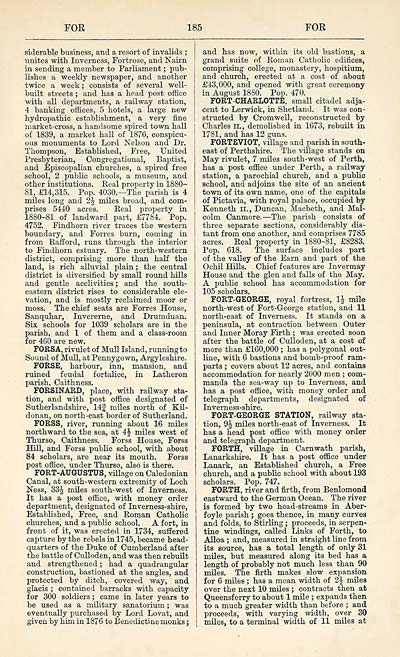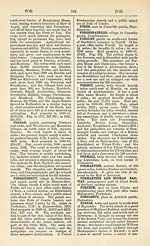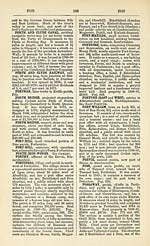Gazetteer of Scotland
(195) Page 185
Download files
Complete book:
Individual page:
Thumbnail gallery: Grid view | List view

FOE
185
FOR
siderable business, and a resort of invalids ;
unites with Inverness, Fortrose, and Nairn
in sending a member to Parliament ; pub-
lishes a weekly newspaper, and another
twice a week ; consists of several well-
built streets ; and has a head post office
with all departments, a railway station,
4 banking offices, 5 hotels, a large new
hydropathic establishment, a very fine
market-cross, a handsome spired town hall
of 1839, a market hall of 1876, conspicu-
ous monuments to Lord Nelson and Dr.
Thompson, Established, Free, United
Presbyterian, Congregational, Baptist,
and Episcopalian churches, a spired free
school, 2 public schools, a museum, and
other institutions. Real property in 1880-
81, £14,315. Pop. 4030.— The parish is 4
miles long and 2\ miles broad, and com-
prises 5440 acres. Eeal property in
1880-81 of landward part, £7784. Pop.
4752. Findhorn river traces the western
boundary, and Forres burn, coming in
from Rafford, runs through the interior
to Findhorn estuary. The north-western
district, comprising more than half the
land, is rich alluvial plain ; the central
district is diversified by small round hills
and gentle acclivities ; and the south-
eastern district rises to considerable ele-
vation, and is mostly reclaimed moor or
moss. The chief seats are Forres House,
Sanquhar, Invererne, and Drumduan.
Six schools for 1039 scholars are in the
parish, and 1 of them and a class-room
for 460 are new.
FORSA, rivulet of Mull Island, runningto
Sound of Mull, at Pennygown, Argyleshire.
FORSE, harbour, inn, mansion, and
ruined feudal fortalice, in Latheron
parish, Caithness.
FORSINARD, place, with railway sta-
tion, and with post office designated of
Sutherlandshire, 14f miles north of Kil-
donan, on north-east border of Sutherland.
FORSS, river, running about 16 miles
northward to the sea, at 4J miles west of
Thurso, Caithness. Forss House, Forss
Hill, and Forss public school, with about
84 scholars, are near its mouth. Forss
post office, under Thurso, also is there.
FORT-AUGUSTUS, village on Caledonian
Canal, at south-western extremity of Loch
Ness, 33J miles south-west of Inverness.
It has a post office, with money order
department, designated of Inverness-shire,
Established, Free, and Roman Catholic
churches, and a public school. A fort, in
front of it, was erected in 1734, suffered
capture by the rebels in 1745, became head-
quarters of the Duke of Cumberland after
the battle of Culloden, and was then rebuilt
and strengthened ; had a quadrangular
construction, bastioned at the angles, and
protected by ditch, covered way, and
glacis ; contained barracks with capacity
for 300 soldiers ; came in later years to
be used as a military sanatorium ; was
eventually purchased by Lord Lovat, and
given by him in 1876 to Benedictine monks ;
and has now, within its old bastions, a
grand suite of Roman Catholic edifices,
comprising college, monastery, hospitium,
and church, erected at a cost of about
£43,000, and opened with great ceremony
in August 1880. Pop. 470.
FORT-CHARLOTTE, small citadel adja-
cent to Lerwick, in Shetland. It was con-
structed by Cromwell, reconstructed by
Charles II., demolished in 1673, rebuilt in
1781, and has 12 guns.
FORTEVIOT, village and parish in south-
east of Perthshire. The village stands on
May rivulet, 7 miles south-west of Perth,
has a post office under Perth, a railway
station, a parochial church, and a public
school, and adjoins the site of an ancient
town of its own name, one of the capitals
of Pictavia, with royal palace, occupied by
Kenneth II., Duncan, Macbeth, and Mal-
colm Canmore.- — The parish consists of
three separate sections, considerably dis-
tant from one another, and comprises 7785
acres. Real property in 1880-81, £8283.
Pop. 618. The surface includes part
of the valley of the Earn and part of the
Ochil Hills. Chief features are Invermay
House and the glen and falls of the May.
A public school has accommodation for
105 scholars.
FORT-GEORGE, royal fortress, \\ mile
north-west of Fort-George station, and 11
north-east of Inverness. It stands on a
peninsula, at contraction between Outer
and Inner Moray Firth ; was erected soon
after the battle of Culloden, at a cost of
more than £160,000 ; has a polygonal out-
line, with 6 bastions and bomb-proof ram-
parts ; covers about 12 acres, and contains
accommodation for nearly 2000 men ; com-
mands the sea-way up to Inverness, and
has a post office, with money order and
telegraph departments, designated of
Inverness-shire.
FORT-GEORGE STATION, railway sta-
tion, 9Jj miles north-east of Inverness. It
has a head post office with money order
and telegraph department.
FORTH, village in Carnwath parish,
Lanarkshire. It has a post office under
Lanark, an Established church, a Free
church, and a public school with about 193
scholars. Pop. 747.
FORTH, river and firth, from Benlomond
eastward to the German Ocean. The river
is formed by two head-streams in Aber-
foyle parish ; goes thence, in many curves
and folds, to Stirling ; proceeds, in serpen-
tine windings, called Links of Forth, to
Alloa ; and, measured in straight line from
its source, has a total length of only 31
miles, but measured along its bed has a
length of probably not much less than 90
miles. The firth makes slow expansion
for 6 miles ; has a mean width of 2\ miles
over the next 10 miles ; contracts then at
Queensferry to about 1 mile ; expands then
to a much greater width than before ; and
proceeds, with varying width, over 30
miles, to a terminal width of ll miles at
185
FOR
siderable business, and a resort of invalids ;
unites with Inverness, Fortrose, and Nairn
in sending a member to Parliament ; pub-
lishes a weekly newspaper, and another
twice a week ; consists of several well-
built streets ; and has a head post office
with all departments, a railway station,
4 banking offices, 5 hotels, a large new
hydropathic establishment, a very fine
market-cross, a handsome spired town hall
of 1839, a market hall of 1876, conspicu-
ous monuments to Lord Nelson and Dr.
Thompson, Established, Free, United
Presbyterian, Congregational, Baptist,
and Episcopalian churches, a spired free
school, 2 public schools, a museum, and
other institutions. Real property in 1880-
81, £14,315. Pop. 4030.— The parish is 4
miles long and 2\ miles broad, and com-
prises 5440 acres. Eeal property in
1880-81 of landward part, £7784. Pop.
4752. Findhorn river traces the western
boundary, and Forres burn, coming in
from Rafford, runs through the interior
to Findhorn estuary. The north-western
district, comprising more than half the
land, is rich alluvial plain ; the central
district is diversified by small round hills
and gentle acclivities ; and the south-
eastern district rises to considerable ele-
vation, and is mostly reclaimed moor or
moss. The chief seats are Forres House,
Sanquhar, Invererne, and Drumduan.
Six schools for 1039 scholars are in the
parish, and 1 of them and a class-room
for 460 are new.
FORSA, rivulet of Mull Island, runningto
Sound of Mull, at Pennygown, Argyleshire.
FORSE, harbour, inn, mansion, and
ruined feudal fortalice, in Latheron
parish, Caithness.
FORSINARD, place, with railway sta-
tion, and with post office designated of
Sutherlandshire, 14f miles north of Kil-
donan, on north-east border of Sutherland.
FORSS, river, running about 16 miles
northward to the sea, at 4J miles west of
Thurso, Caithness. Forss House, Forss
Hill, and Forss public school, with about
84 scholars, are near its mouth. Forss
post office, under Thurso, also is there.
FORT-AUGUSTUS, village on Caledonian
Canal, at south-western extremity of Loch
Ness, 33J miles south-west of Inverness.
It has a post office, with money order
department, designated of Inverness-shire,
Established, Free, and Roman Catholic
churches, and a public school. A fort, in
front of it, was erected in 1734, suffered
capture by the rebels in 1745, became head-
quarters of the Duke of Cumberland after
the battle of Culloden, and was then rebuilt
and strengthened ; had a quadrangular
construction, bastioned at the angles, and
protected by ditch, covered way, and
glacis ; contained barracks with capacity
for 300 soldiers ; came in later years to
be used as a military sanatorium ; was
eventually purchased by Lord Lovat, and
given by him in 1876 to Benedictine monks ;
and has now, within its old bastions, a
grand suite of Roman Catholic edifices,
comprising college, monastery, hospitium,
and church, erected at a cost of about
£43,000, and opened with great ceremony
in August 1880. Pop. 470.
FORT-CHARLOTTE, small citadel adja-
cent to Lerwick, in Shetland. It was con-
structed by Cromwell, reconstructed by
Charles II., demolished in 1673, rebuilt in
1781, and has 12 guns.
FORTEVIOT, village and parish in south-
east of Perthshire. The village stands on
May rivulet, 7 miles south-west of Perth,
has a post office under Perth, a railway
station, a parochial church, and a public
school, and adjoins the site of an ancient
town of its own name, one of the capitals
of Pictavia, with royal palace, occupied by
Kenneth II., Duncan, Macbeth, and Mal-
colm Canmore.- — The parish consists of
three separate sections, considerably dis-
tant from one another, and comprises 7785
acres. Real property in 1880-81, £8283.
Pop. 618. The surface includes part
of the valley of the Earn and part of the
Ochil Hills. Chief features are Invermay
House and the glen and falls of the May.
A public school has accommodation for
105 scholars.
FORT-GEORGE, royal fortress, \\ mile
north-west of Fort-George station, and 11
north-east of Inverness. It stands on a
peninsula, at contraction between Outer
and Inner Moray Firth ; was erected soon
after the battle of Culloden, at a cost of
more than £160,000 ; has a polygonal out-
line, with 6 bastions and bomb-proof ram-
parts ; covers about 12 acres, and contains
accommodation for nearly 2000 men ; com-
mands the sea-way up to Inverness, and
has a post office, with money order and
telegraph departments, designated of
Inverness-shire.
FORT-GEORGE STATION, railway sta-
tion, 9Jj miles north-east of Inverness. It
has a head post office with money order
and telegraph department.
FORTH, village in Carnwath parish,
Lanarkshire. It has a post office under
Lanark, an Established church, a Free
church, and a public school with about 193
scholars. Pop. 747.
FORTH, river and firth, from Benlomond
eastward to the German Ocean. The river
is formed by two head-streams in Aber-
foyle parish ; goes thence, in many curves
and folds, to Stirling ; proceeds, in serpen-
tine windings, called Links of Forth, to
Alloa ; and, measured in straight line from
its source, has a total length of only 31
miles, but measured along its bed has a
length of probably not much less than 90
miles. The firth makes slow expansion
for 6 miles ; has a mean width of 2\ miles
over the next 10 miles ; contracts then at
Queensferry to about 1 mile ; expands then
to a much greater width than before ; and
proceeds, with varying width, over 30
miles, to a terminal width of ll miles at
Set display mode to: Large image | Transcription
Images and transcriptions on this page, including medium image downloads, may be used under the Creative Commons Attribution 4.0 International Licence unless otherwise stated. ![]()
| Gazetteers of Scotland, 1803-1901 > Gazetteer of Scotland > (195) Page 185 |
|---|
| Permanent URL | https://digital.nls.uk/97357561 |
|---|

